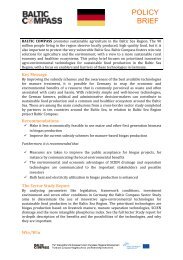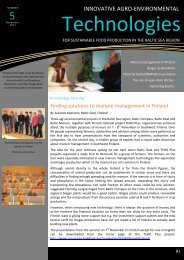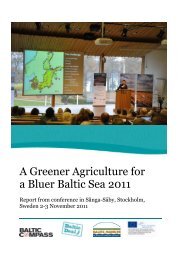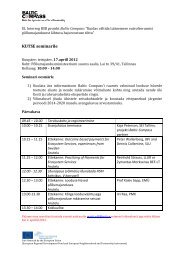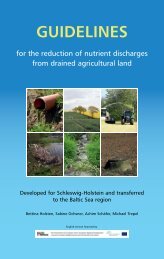21. Promoting long-term grass cultivation of arable landCultivation of grass or legume/grass crops on arable land with high/low inputs ofnitrogen (N) and phosphorus (P) and high/low outputs of feed, food or other servicescan reduce nitrogen and phosphorus leaching and surface run-off losses as well assoil erosion, compared with annual crops on arable land.Crop rotations including permanent grass or legume/grass crops can decrease Nleaching with 50%, compared with crop rotations dominated by annual crops.Describe this measure in your country if different : Grassland cultivation was conductedon totally 1 120 808 hectares year 2009. On 888 800 hectares the grassland washarvested and on 178 210 hectares the grassland was grazed.1. Is there any official quantified goal that states to what extent this measure should beimplemented? Yes• If "Yes";a) specify quantity and unit: 900 000 hectares of cultivated grassland and 41000 enterprisesb) if applicable, what year to be realized? 2013c) give reference(s): The Swedish rural development programme 2007-2013• If "No", what is your expert opinion of the desirable level in 5 years?quantity and unit:2. To what extent is this measure implemented today in relation to goal set above? 10"0"=Not at all; "10"=Goal already reached3. If goal is not reached; how do you judge the possibilities to fulfill it?"0"=Impossible; "10"=Very goodComments: the goals concerning area with grassland are linked to the goals of preservingan open landscape with a high abundance of variation.Comments on why the goal is easy/difficult to reach, what are the most importantparameters in your country:At country level the goal is easy to reach as grasslandcultivatiotraditionally is the most abundant crop on arable land (43% of the area).However, the amount of produced milk is decreasing rapidly in almost the whole area ofnitrate vulnerable zone (last 4 years reduction with 5-15%) which means that the numberof dairy farms is decreasing and consequently the land use will be changed. Only inKalmar and Gotland counties the amount of produced milk is increasing. the cultivation ofmaize on dairy farms has last years increased. If the cultivation of maize become moreestablished this will decrease the area of grassland on dairy farms. The legislation ofkeeping dairy cattle on grasslands for grazing during the grazing period has beenquestioned last years. If there is a change so that more dairy cows can be kept indoors allthe year around the land use will be changed.Is this measure regulated in legislation? Yes If “Yes”; national or regional rulesReference(s) to legislation:The Swedish board of Agriculture rules and general guidance(SJVFS 2004:62, updated version 2010:55) (SJVFS 1998:915).Comments: Grassland is also one of the crops accepted to use to reduce nitrogenleaching.
3Is this measure entitled to economic subsidy? Yes If “Yes”; national or regionalsubsidy rulesReference(s) to subsidy rules:The Swedish rural development programme 2007-2013.Comments: Whole <strong>Sweden</strong> has a basic subsidy level. The subsidy level can be increaseddepending on if the farm also has livestock production and depending on if the farm islocated in nitrate vulnerable zone.2. Vegetative cover in autumn and winter of arable landAnnual winter crops, such as winter wheat or winter rape, can provide a vegetativecover that actively takes up available nitrogen and phosphorus from the soil moreefficient than annual spring crops at a seasonal period with high precipitation andcool climate.Catch crops can be under-sown in the main crop, simultaneously with, or just afterthe sowing of this crop. When the main crop is harvested, the catch crop has anestablished root system ready to take up nitrogen from the soil during late summerand autumn. Nitrogen that otherwise could have been leached is then taken up andincorporated into plant material. The catch crop is then ploughed-in as late aspossible in autumn or in spring. Perennial ryegrass (Lolium perenne L.) as a catchcrop is an effective measure to reduce N leaching in spring cereal crop production.The use of catch crops has reduced N leaching by 50% or more in several studies.The effect of the catch crop on N leaching depends on precipitation and drainageconditions, available N amounts in soil and how successful the establishment of thecatch crop was.Describe this measure in your country if different : Approved crops for arable land to beregarded as autumn- or winter-covered are; 1. grass, 2. autumn oilseed crops, 3. wintercereals, 4. sugar beet, feed sugar and feed beet, carrots, beetroots and other similar rootcrops, 5. perennial fruit and berry crops, 6. short rotation forestry, and 7. catch crops.Arable land which is lying fallow following the cultivation of cereals and oilseed crops mayalso be counted as autumn or winter-sown, but only if the land lies fallow from when cerealcrops come into ear or from flowering in the case of oilseed crops.For arable land to be regarded as autumn- or winter-covered, main crops and any catchcrops for which growth will be stopped during the next spring season must be sown; 1. by5 October in the counties of Östergötland, Jönköping, Kronoberg, Kalmar, Gotland andVästra Götaland, and 2. by 15 October in the counties of Blekinge, Skåne and Halland.In order for arable land to be considered autumn-sown, the cultivation of grass, perennialfruit and berry plants, short rotation forestry and catch crops sown before 1 August mustbe stopped; 1. no earlier than 10 October in the counties of Östergötland, Jönköping,Kronoberg, Kalmar, Gotland and Västra Götaland, and 2. no earlier than 20 October in thecounties of Blekinge, Skåne and Halland. In the counties of Blekinge, Skåne and Halland,arable land sown before 20 August with catch crops in the form of white mustard andfodder radish may be considered autumn-sown. The growth of white mustard and fodderradish may be stopped no earlier than 20 October. Arable land lying fallow after cereal andoilseed crops may be cultivated or controlled chemically no earlier than 10 October.In order for arable land to be considered autumn or winter-sown; 1. the growth of catchcrops sown on or after 1 August must be stopped at the earliest during the following springseason, and 2. the growth of grass and catch crops containing more than one quarter of



